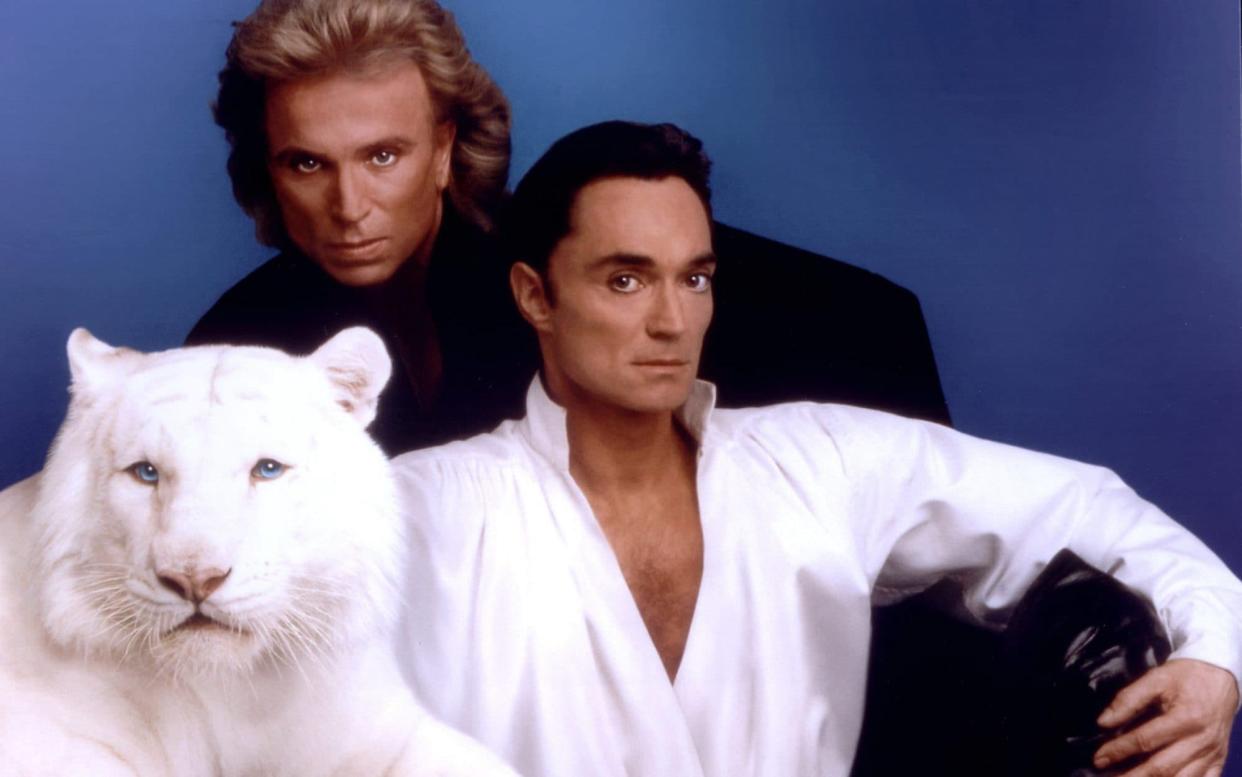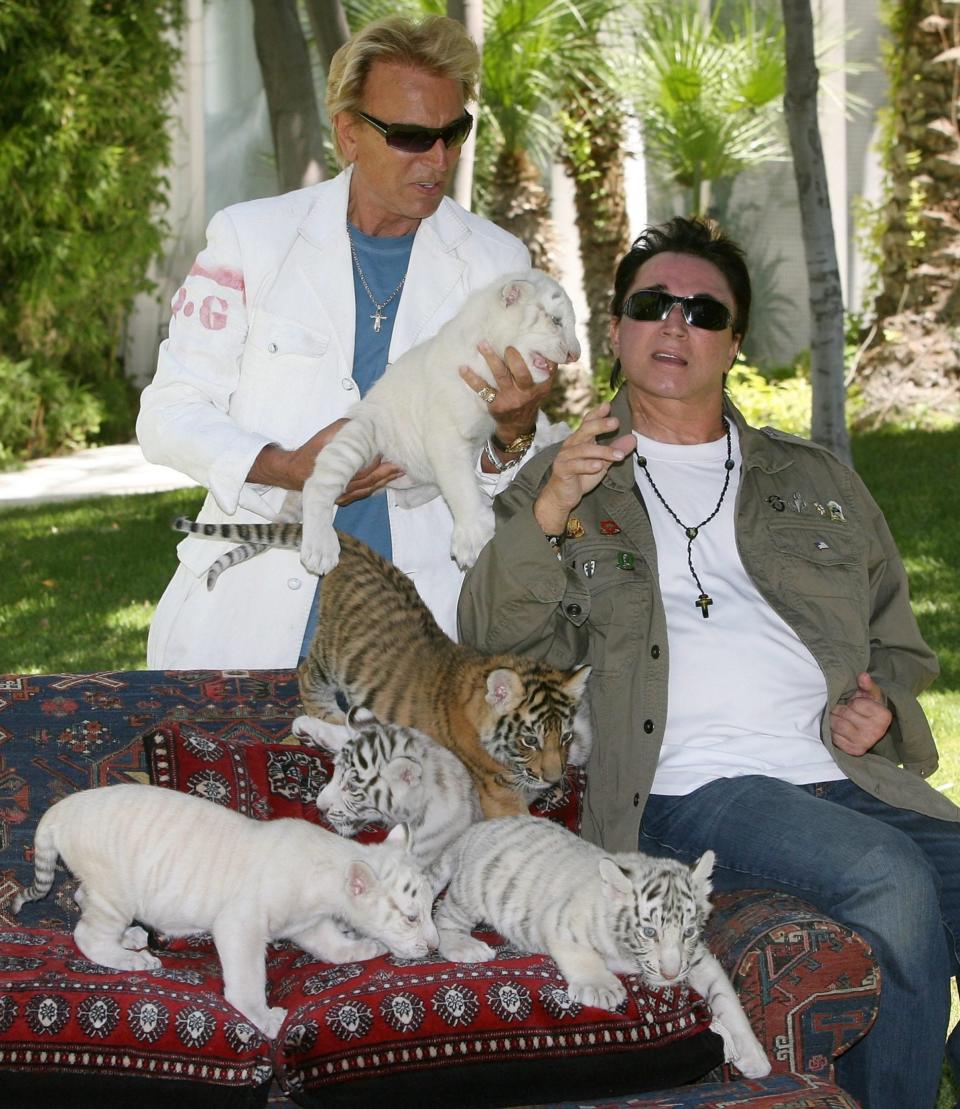Roy Horn, who formed half of the magic and animal duo Siegfried and Roy – obituary

Roy Horn, who has died aged 75 after contracting Covid-19, was an entertainer who formed half of the magic and wild animal act, Siegfried and Roy. With his partner, Siegfried Fischbacher, he combined the glamour of Las Vegas with the thrill of the jungle.
But before a packed audience at the Mirage Hotel-Casino in Las Vegas in 2003, a huge male white tiger named Mantacore (sometimes given as Montecore or Mantecore) leapt at Horn, who had tapped him on the nose with his microphone. Horn was knocked to the ground and bitten badly in the neck before handlers rushed to his aid.
Despite his injuries, as he was being taken away to hospital, he said: “Mantacore is a great cat. Make sure no harm comes to Mantacore.”
Horn sustained severe blood loss and injuries from which he did not fully recover, but a year later he insisted that he had suffered a stroke and that the tiger had been coming to his aid.
“I fell over,” he said. “Mantacore saw that I was falling down, so he actually took me and brought me to the other exit where everybody could get me and help me. He knew better than I did where to go.”
One animal expert countered that in fact the animal’s behaviour seemed clearly predatory: “When tigers kill prey and they want to move it out from the open into a more safe and secure place, they’ll usually grab it by the neck.”

Uwe Ludwig Horn was born during an air raid on October 3 1944 at Nordenham on Germany’s North Sea coast, the youngest of four children; his father was away fighting on the Russian front.
Uwe’s parents divorced in 1945. His mother remarried, but his stepfather was an alcoholic and his mother had to work to support the family. Lonely and alienated, young Uwe took refuge with his dog, Hexe, and he recalled an incident when he found himself stuck in deep mud in a forest. Hexe, he said, ran off and brought back a local farmer, who rescued Uwe.
Through a family friend who had founded Bremen Zoo he began helping out there, and befriended a cheetah named Chico; he developed such a rapport with the animal that the handlers let him go inside the cage, and even take Chico for walks on a lead. “Every day before I reached the zoo, I gave a special whistle call,” he recalled. “By the time I got there, she had returned my whistle with a chirping birdlike sound.”
Hating school, without his family’s permission he became a bellboy on a ship belonging to the North German line, Lloyd, at the age of 13, but soon returned home, and was given Chico by the zoo. Taking to the sea again as a steward on the TS Bremen – with Chico in tow, smuggled aboard inside a laundry bag – he met Siegfried Fischbacher, who had graduated from steward on the ship to magician.
He was performing with rabbits and doves, and when Roy ventured to suggest that his act was somewhat predictable, Siegfried thought him “some smug little punk”, and challenged him to come up with some improvements. “If you can make a rabbit and a dove appear,” Roy replied, “could you do the same with a cheetah?”
Towards the end of the voyage, Siegfried made Chico “appear”, to general amazement. The pair set up a stand and charged passengers $2.50 to have their photo taken with Chico; nearly 800 took up the offer. They were also offered work by a passenger on the ship, the owner of another cruise company, and their double act developed; Roy was initially the assistant, but was soon an equal, and the pair became domestic as well as professional partners.
In 1964 they took their first theatre booking, at the Astoria in Bremen, one of the last variety theatres in the city. Engagements followed in Lausanne, Madrid, Paris, and Monte Carlo, where they performed at the Sporting Club before such stars as Grace Kelly, Sophia Loren and Elizabeth Taylor.
They graduated to Las Vegas in the latter half of the 1960s, playing the Tropicana. Chico was still part of the act, along with a new cheetah, Simba, and some flamingos from Horn’s uncle’s zoo. The hotel owner had his doubts, however, telling them: “Magic don’t work in this town.”
But they made an immediate splash: on the opening night Chico, distracted by the spotlights, leapt from his trunk and took the toupee off the orchestra’s leader, Ray Sinatra – Frank’s cousin – before landing on the piano.
They rapidly became huge attractions, and after a three-month Vegas residency they played the Lido in Paris for three years. There they had initial problems with Chico, until Horn realised that he was being disturbed by the waiters’ white jackets. Twice a week, Roy fed the cheetah white chickens; when he was onstage and blinded by the spotlights, the waiters’ movements made Chico think they were his chickens.
The Lido management agreed to break with tradition, and put the waiters in red jackets. Siegfried and Roy went on to appear before the Duke and Duchess of Windsor, members of the Rothschild family, Rudolf Nureyev, Margot Fonteyn, Josephine Baker and Brigitte Bardot, as well as performing at Maurice Chevalier’s 80th birthday party.

There followed several profitable years moving between Las Vegas and the Americana Hotel in Puerto Rico. In 1974 they signed up as the star act of “Hallelujah Hollywood” at the MGM Grand Hotel, a show put on by the notorious British manager Don Arden, who in the 1960s had given several pop stars reason to rue the day they became involved with him.
The volatile and ruthless impresario complained when they received five minutes’ applause and proposed cutting their slot from 20 minutes to 15. Roy informed him that if he did that they would leave; Arden laughed, and from then on they enjoyed a good working relationship with him, staying five years at the MGM Grand. In 1976 they were given their first award as Magicians of the Year from the American Academy of Magical Arts.
Their career went into overdrive when Bernie Yuman became their manager. He made them the then highest-paid speciality act in Las Vegas history, and from 1978 to 1981 they played the Stardust Lido there, putting on 15 performances a week to 1,140 capacity audiences.

They followed it with their Beyond Belief show at the Frontier Hotel in the city. It ran for several years, during which time they also squeezed in tours to Japan (where they were the then highest grossing performers in Japanese history), Radio City Music Hall in New York and Germany.
In 1989, Steve Wynn gave them a $57 million contract to star at his new 3,303-room hotel in Las Vegas, the Mirage, and they performed there for six nights a week, 44 weeks a year.
Their company included 60 performers, more than 20 animal handlers and grooms and more than 60 animals, including regular and white tigers, white lions, a black-maned Nubian lion, a snow leopard, black leopard, black panther, a spotted jaguar, a Thai elephant, assorted birds of prey, a python and an Andalusian stallion, which regularly appeared and disappeared on stage.
By 1997 it was claimed they had been seen at the Mirage by some 20 million people, grossed more than £350 million and held the box office record for a single attraction in Las Vegas. Their television spectaculars made them famous throughout the US and in Europe. In 1999 they received a star on the Hollywood Walk of Fame.
The duo created a huge home in the Nevada desert, “Jungle Palace”, which they shared with their animals, including dozens of lions and tigers, and later lived on a vast retreat known as “Little Bavaria”.
Following Horn’s bloody encounter with Mantacore, it took until 2006 before he could walk, and talk with assistance. In 2009 the duo staged a benefit performance for the Lou Ruvo Center for Brain Health in Las Vegas – ostensibly with Mantacore, although the handler who had dragged the tiger off Horn said that a different animal was used.
The following year Siegfried and Roy, who had become US citizens, announced their retirement. Mantacore, who had brought their career to an end, died in 2014.
Roy Horn, born October 3 1944, died May 8 2020

